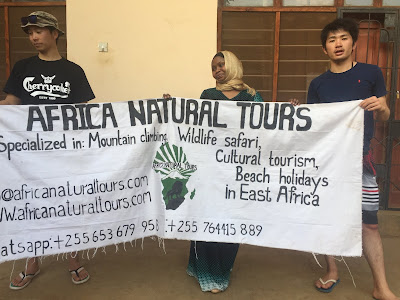Tarangire National Park Guide - Africa Natural Tours ( africanaturaltours.com )
Tarangire
National Park Guide:
Africa Natural Tours (For Kilimanjaro, Serengeti and
Zanzibar) Tanzania safari company in Moshi
Specialized
in: Wildlife safaris, Mountain climbing,
Cultural tourism and Beach holidays in East Africa
Contact
+255 653 679 958
Email: info@africanaturaltours.com
Website: www.africanaturaltours.com
Tarangire
National Park Guide
Tarangire National Park background
The
Tarangire National Park is a diverse and picturesque African wildlife sanctuary
and is located just southeast of Lake Manyara on the Tarangire River, from
which it derived its name. During the annual dry season (from August to
October), the 2600 sq km Tarangire National Park attracts one of the highest
concentrations of wildlife animals in Tanzania. During this time, the River
provides the only permanent water in the area and forms a “dry season retreat”
for the animals of the southern Massailand in Tanzania. There are normally
fewer safari tourists visiting the Tarangire National Park compared to the
Ngorongoro National Park, which makes this African national park even more
attractive. Safari activities are normally centered on game drives featuring excellent
landscapes views of beautiful riverine forests, acacia woodlands, ancient
African baobab trees and endless rolling hills. This alone makes the Tarangire
National Park really worthwhile visiting. The park is reputed to contain some
of the largest elephant herds in Tanzania or even in Africa. This African
national park is also home to three rare species of animals – the Greater Kudu,
the Fringed-eared Oryx, as well as a few Ashy Starlings.
Please
refer to the map below for further details, images and safari information guide
on this awesome and picturesque wildlife national park in Tanzania.
Tarangire migration
The
Tarangire National Park forms part of a bigger wildlife ecosystem covering over
20,000 sq km, which include the Lake Manyara National Park in the north, as
well as five other surrounding wildlife controlled areas. The key to this
wildlife ecosystem is the Tarangire River, and the local animal migration in
the area begins from this river, at the start of the short rainy season around
October every year. At the height of the long rainy season, the animals, which
include wildebeest, Thompson gazelles, zebra and even African elephants, will
be widely spread out over this 20,000 sq km area. When the wet season ends, the
animals begin their migration back towards the river and spend the dry season
July to October, concentrated in large numbers around the river.
Tarangire routes
The
Lemiyon route covers the most northerly triangle of the Tarangire National
Park. The park headquarters, airstrip and the public campsites are located in
this section of the national park. During the dry season, animals are very
often encountered in great numbers in this area and this is also where you will
see some really fascinating and majestic African baobab trees. Many of them are
very, very old, dating back to the first millennium. One particular famous one,
known as the “Poachers Lookout Tree”, features a small man-made entrance that
leads you into its hollow interior, which easily provides room for about six
people to sleep in. To avoid detection by park warden patrols, poachers utilized
this now famous tree, some years ago. Beyond the Lemiyon route, the park is
split into the Matete route in the east and the Lake Burungi route to the west.
The
eastern Matete route, named after the tall elephant grass and reeds that grow
on the Tarangire riverbanks, usually provides the best option for game viewing.
Wildlife and more specifically the birdlife, is prolific in this area.
The
western Lake Burungi route, a pleasant drive of about 80 km, meanders through
combretum (a genus of about 250 species of trees and shrubs native to Africa)
and acacia woodlands. With a bit of luck it is quite possible to encounter
leopard and rhino in this area. The route also features lovely views of lakes
Burungi and Manyara as well as the peaks of Milima Mitatu or “Three Hills”.
The
Kitibong Hill route also covers the western section of the Tarangire National
Park and is centered on the Kitibong Hill. The route features combretum, acacia
woodlands, the Gursi floodplains to the south, as well as a large variety of
plain animals, including buffalo and elephant.
The
Gursi and Lamarkau routes are located in southern part of the park and mainly
features grasslands, home to many plain grazing species, including the ostrich.
During the wet season, large areas in this region are transformed to swamp
areas, where it is possible to see hippo. The most southern end of the park is
split into two areas known as Mkungunero (south-west) and Nguselororobi (east),
which offers a number of freshwater pools, attracting many different species,
including the illusive cheetah, if you are lucky.
When to visit Tarangire National
Park
The
first migrating animals start to arrive in the park during early June, and will
remain in the park until November – just before the start of the short rainy
season – when the migration moves north again. This annual wildlife Tarangire
migration makes for fantastic safari game viewing in the dry season.
Don’t
fret if you cannot coincide your trip with the annual migration period – many
animals including African elephants, lions, cheetahs, leopards, hyenas,
buffaloes, giraffes, zebras, a wide range of antelopes and warthogs – stay in
the park all year round. Although the park offers many animals to be seen
during the rainy season – you will however have to content with lush
vegetation, rain and the plentiful insect population. June to March is the
dryer months with June to October the prime time to visit.
Tarangire lodges and camps
There
are several tented camps and luxury lodges available around Tarangire National
Park area. Visit the Tarangire National Park lodges and camp sites page
for more information.
For more information
visit www.africanaturaltours.com




Comments
Post a Comment